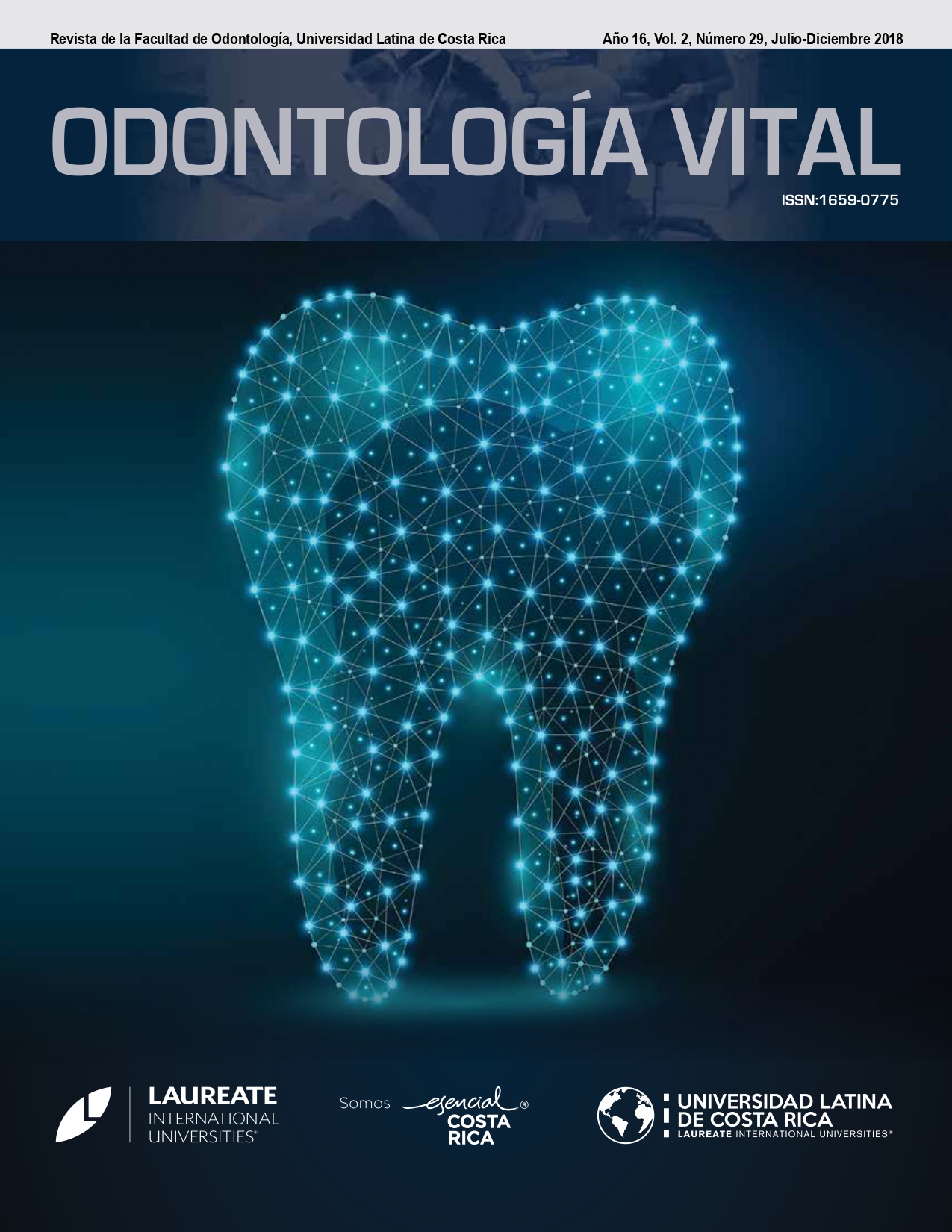Maxillary and mandibular oral rehabilitation with hybrid prostheses, using conventional one and two phase implants and zygomatic implants in patient with ectodermal dysplasia. Clinical case
DOI:
https://doi.org/10.59334/ROV.v2i29.152Keywords:
Zygomatic Implants, All-on-four, Ectodermal dysplasiaAbstract
The edentulous patient and his oral rehabilitation, specially with severe bone reabsorption is really a challenge for the clinician. In many situations the clinician requires additional procedures such as bone grafting in order to gain bone volume and finally be able to place the dental implants. In this article, we describe a patient with ectodermic dysplasia, who has some impacted teeth and severe bone reabsorption. In this case multiple dental extractions were performed and the placement of zygomatic implants with propose to avoid any bone grafting and be able to rehabilitated the patient at much less morbility, less cost and time.
Downloads
References
Aparicio C. A., (2011). Proposed classification for zygomatic implant patients based on the zygoma anatomy guided approach (ZAGA): a cross-sectional survey. Eur J Oral Implantol ; 4 (3): 269-275.
Balshi, T.J., Wolfinger, G.J., Shuscavage, N.J., et ál. (2012). Zygomatic bone-to-implant contact in 77 patients with partially or completely edentulous maxillas. J Oral Maxillofac Surg ;70(9):2065–9. https://doi.org/10.1016/j.joms.2012.05.016
Bedrossian, E., Sullivan, R,. Malo, P. (2008). Implant restoration of edentulous maxilla. J Oral Maxillofac Surg 66:112-122. https://doi.org/10.1016/j.joms.2007.06.687
Block, M., Haggerty, C., Fisher, R. (2009). Nongrafting implant options for restoration of the edentulous maxilla. J Oral Maxillofac Surg 67:872-881. https://doi.org/10.1016/j.joms.2008.10.008
Brånemark, P-I. (1998). Surgery and fixture installation: zygomaticus fixture clinical procedures. (ed 1). Goteborg, Sweden: Nobel Biocare AB .
Branemark, P.I., Grondahl, K., Ohrnell, L.O., et ál. (2004). Zygoma fixture in the management of advanced atrophy of the maxilla: technique and long-term results. Scand J Plast Reconstr Surg Hand Surg ;38(2):70–85. https://doi.org/10.1080/02844310310023918
Calandriello, R., Tomatis, M. (2005). Simplified treatment of the atrophic posterior maxilla via immediate/early function and tilted implants: a prospective 1- year clinical study. Clin Implant Dent Relat Res ; 7:S1-12. https://doi.org/10.1111/j.1708-8208.2005.tb00069.x
Duarte, L.R., Filho, H.N., Francischone, C.E., et ál: (2007). The establishment of a protocol for the total rehabilitation of atrophic maxillae employing four zygomatic fixtures in an immediate loading system—A 30 month clinical and radiographic follow-up. Clin Implant Dent Relat Res 9:186.
Leighton, Y., Von Marttens, A., Carvajar, JC. (2007). Immediate prosthetic function with All on-4 mandibular technique: First report after 1 year of immediate loading. Rev. Clin. Periodoncia Implantol. Rehabil. Oral Vol. 7 . p-3
M.F. Pintor Willcock, O. Campos Salvaterra. (2007). Nueva indicación de implantes zigomáticos para la rehabilitación fija de desdentados. Caso clínico. Revista Española Cirugía Oral y Maxilofacial. p-1-2. https://doi.org/10.4321/S1130-05582007000400007
Mac Demot, KO., Winter, RM., Malcom, S. (1996). Gene Hipohidrotic Ectodermal Dysplasia (G-S-T syndrome). Malo, P., Araujo, M., Lopes, A., (2011). The rehabilitation of complete edentulous maxillae with four or more immediately loaded implants: a 5 year retrospective study and new classification. Eur J Oral Implantol ;4(3):227-243
Maló, P., Nobre, M., Lopes, I. (2008). A new approach to rehabilitate the severely atrophic maxilla using extramaxillary anchored implants in immediate function: a pilot study. J Prosthet Dent ; 100:354-366. https://doi.org/10.1016/S0022-3913(08)60237-1
Maló, P., Rangert, B., Eng, M., Nobre, M. (2005). All-on-4, immediate function concept with Branermark system implants for completely edentulous maxillae. 7. https://doi.org/10.1111/j.1708-8208.2005.tb00080.x
Maló, P., Rangert, B., Nobre, M. (2003). “All-on-Four” immediate function concept with Brånemark System® implants for completely edentulous maxillae: A 1-year retrospective clinical study. Clin Implant Dent Relat Res ;7 (Suppl 1):88-94. https://doi.org/10.1111/j.1708-8208.2005.tb00080.x
Nkenke, E., Hahn, M., Lell, M., et ál. (2003). Anatomic site evaluation of the zygomatic bone for dental implant placement. Clin Oral Implants Res ;14(1):72–9. https://doi.org/10.1034/j.1600-0501.2003.140110.x
Penarrocha, M., García, B., Martí, E., et ál (2007). : Rehabilitation of severely atrophic maxillae with fixed implant-supported prostheses using zygomatic implants placed using the sinus slot technique: Clinical report on a series of 21 patients. Int J Oral Maxillofac Implants 22:645.
Robert, E., Marx, DDS., Diane Stern, DDS, MS. (2012). Oral and maxillofacial pathology, a rationale for diagnosis and treatment. Quintessence Publishing Co, Inc. ; 256-257-258
Uchida, Y., Goto, M., Katsuki, T., et ál. (2001). Measurement of the maxilla and zygoma as an aid in installing zygomatic implants. J Oral Maxillofac Surg ;59(10):1193–8. https://doi.org/10.1053/joms.2001.26725
Downloads
Published
Issue
Section
License
Copyright (c) 2018 Iván Navarro, Adrián Brenes, Dashiel Carr, José Ramos

This work is licensed under a Creative Commons Attribution 4.0 International License.
Authors who publish with Odontología Vital agree to the following terms:
- Authors retain the copyright and grant Universidad Latina de Costa Rica the right of first publication, with the work simultaneously licensed under a Creative Commons Attribution 4.0 International license (CC BY 4.0) that allows others to share the work with an acknowledgement of the work's authorship and initial publication in this journal.
- Authors are able to enter into separate, additional contractual arrangements for the non-exclusive distribution of the Odontología Vital's published version of the work (e.g., post it to an institutional repository or publish it in a book), with an acknowledgement of its initial publication.
- Authors are permitted and encouraged to post their work online (e.g., in institutional repositories or on their website) prior to and during the submission process, as it can lead to productive exchanges, as well as earlier and greater citation of published work.







